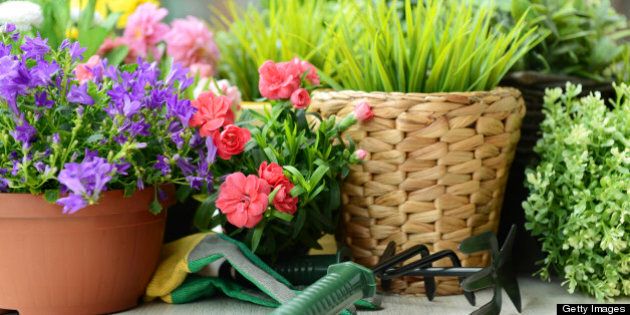
When the warm weather arrives, every homeowner has an inventory of outside chores: cutting the lawn, weeding the garden, washing windows and cleaning the eaves are at the top of every list, including mine. This year however, I'm adding some new 'must-do' items to make the outdoors more enjoyable.
1. Top dress the lawn. I'm taking top-dressing a step further and reseeding my entire lawn this spring! Every July when the hot weather hits, I have yellow patches in my grass. I've been told slugs or hot dry weather are the culprits. The truth is, most of our lawns are Kentucky Blue Grass which naturally goes dormant in the heat. To combat this, I will add a second variety of seed, a rye fescue, because it stays green all season long. Do this by adding a 2-kilogram bag of seed to a 20-pound bag of top soil, mix them in a wheelbarrow, and spread across your existing grass. The 'seed-to-soil' contact is what makes this work!
2. Remove the mold. As an allergy sufferer, getting rid of the mold that forms in damp, warm weather is extremely important. Washing the outdoor cushions is only one part of the equation. Mold can form on decks, furniture, siding and eaves troughs. I use a two-step process to effectively remove the mold. First I wash away all the surface dirt, grime and mildew with a product called Concrobium House & Deck wash. Not only is it safe around the plants, so I don't have to cover all my shrubs, it doesn't contain bleach so it won't damage the deck. I also have old stains that are deep in the wood so the second step I take is to use Concrobium's Mold Stain Eraser product that removes just the staining without damaging the wood. I also love that it doesn't require any scrubbing. Now my siding is spotless, everything made of plastic looks new again and I can finally get rid of those mold spots on my wooden deck.
3. Wash the salt. I never use salt outside my home but it still gets tracked onto the path and driveway from city streets and sidewalks. Salt damage to plants and grass happens as the snow melts or as rain carries the deposits into the yard. This build up in the soil can be very damaging and can increase after every winter. One of the best ways to remove the salt from damaged areas is with a mild vinegar-water solution. A half teaspoon of white vinegar to one litre of water makes a great rinse for removing salt from concrete or asphalt. I use a stiff bristle boat mop to make the job quick and easy.
4. Mulch late! Mulching in the spring is very important but most people do it too early. I've always tried to mulch when the snow melts to conserve water by keeping the ground moist. Unfortunately, this slows growth in my gardens. Mulch acts as an insulator, protecting the plants from the elements. However, if you spread it before the soil is completely thawed the mulch keeps the ground colder for longer! The best time to mulch is when the ground is 5 to 7 degrees celsius. You can measure ground temperatures by completely burying a thermometer in a re-sealable bag.
Our time outside is short in Canada so everyone wants to be outside as much as possible. My tips will help keep your spaces looking their best all summer long!